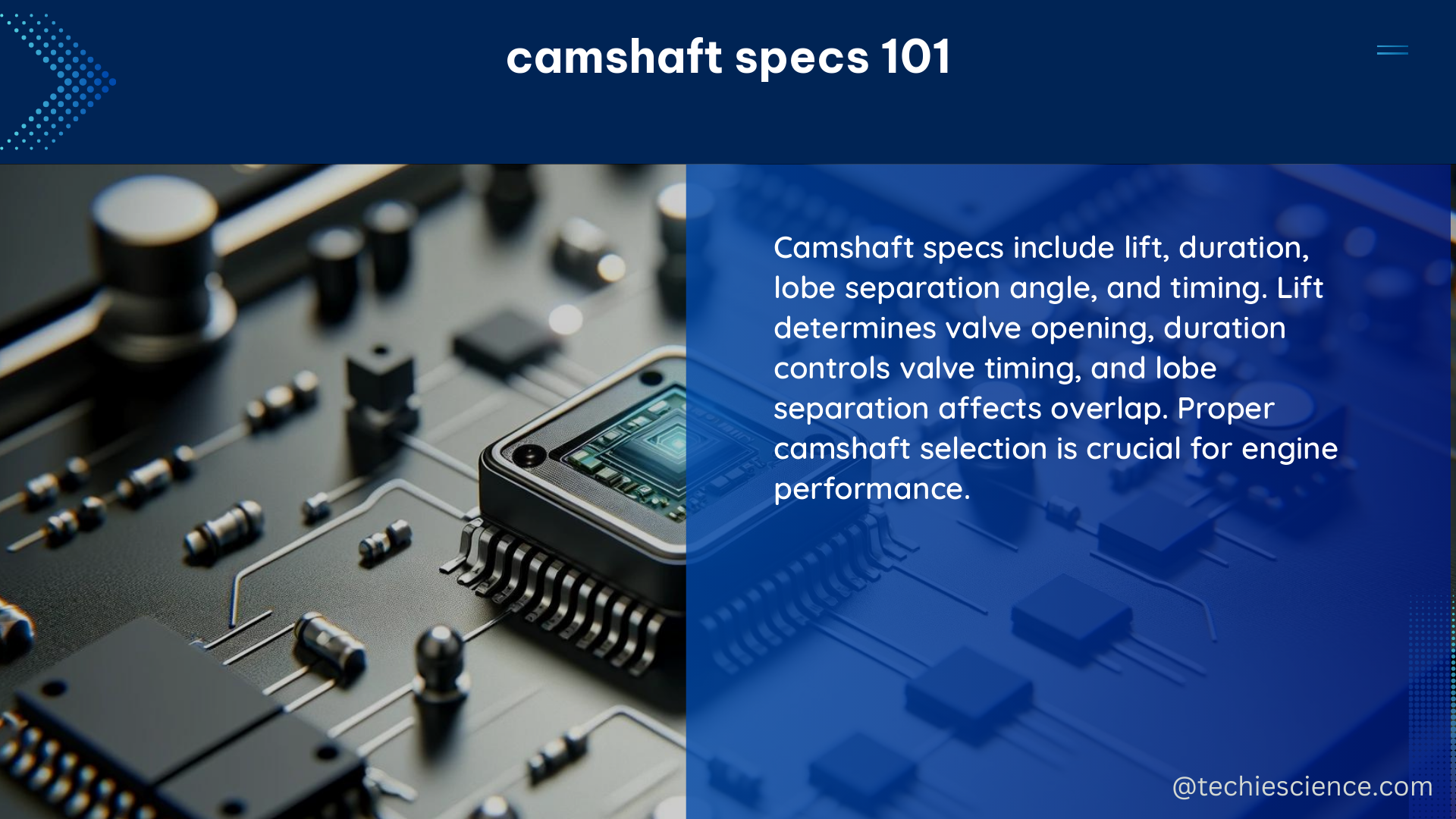Camshaft specifications, or cam specs, are the fundamental parameters that define the performance characteristics of an engine. These specs are crucial for engine builders, performance enthusiasts, and anyone looking to optimize their vehicle’s power output. In this comprehensive guide, we’ll dive deep into the world of camshaft specs, exploring each key metric and its impact on engine performance.
Duration: The Heartbeat of the Engine
The duration of a camshaft is the amount of time, measured in crankshaft degrees, that the valve is off its seat, allowing air and fuel to enter or exhaust gases to exit. This parameter is typically measured at 0.050 inches of lift, which is the point where the valve has just started to open. A longer duration generally means more power, but it can also lead to decreased drivability and fuel efficiency.
- Intake Duration: The number of crankshaft degrees the intake valve is open, typically ranging from 200 to 280 degrees.
- Exhaust Duration: The number of crankshaft degrees the exhaust valve is open, typically ranging from 200 to 280 degrees.
- Relationship between Duration and Power: Longer duration cams tend to produce more power at higher RPMs, while shorter duration cams are better suited for low-end torque and drivability.
Lift: The Valve’s Reach

Lift is the maximum distance the valve is lifted off its seat, measured in inches. This parameter is determined by the shape and size of the cam lobe. Higher lift can result in increased power, but it may also require larger valves, ports, and other modifications to the engine.
- Intake Lift: The maximum lift of the intake valve, typically ranging from 0.400 to 0.600 inches.
- Exhaust Lift: The maximum lift of the exhaust valve, typically ranging from 0.400 to 0.600 inches.
- Relationship between Lift and Power: Increased lift allows for more airflow, leading to higher power output, but it can also create challenges with valve train stability and engine compatibility.
Lobe Separation Angle (LSA): The Balancing Act
The Lobe Separation Angle (LSA) is the angle between the intake and exhaust lobes on the camshaft, measured in camshaft degrees. This parameter plays a crucial role in the engine’s power delivery and characteristics.
- Typical LSA Range: Lobe Separation Angles typically range from 106 to 118 degrees.
- Relationship between LSA and Performance: A wider LSA can improve low-end torque, while a narrower LSA can increase high-end power. The optimal LSA depends on the engine’s intended use and performance goals.
Advertised Duration: The Marketing Metric
Advertised duration is the duration measured at the maximum lift of the cam lobe, rather than at 0.050 inches of lift. This metric is often used for marketing purposes, as it can make a camshaft seem more powerful than it actually is.
- Relationship between Advertised Duration and Actual Performance: Advertised duration can be misleading, as it does not accurately reflect the camshaft’s real-world performance characteristics. Engine builders and enthusiasts should focus on the duration measured at 0.050 inches of lift for a more accurate assessment.
Centerline: The Camshaft’s Alignment
The centerline is the point on the camshaft where the intake and exhaust lobes are equidistant from the camshaft’s centerline. This parameter is often expressed as a degree value and can have a significant impact on engine performance.
- Typical Centerline Range: Camshaft centerlines typically range from 104 to 116 degrees.
- Relationship between Centerline and Performance: Adjusting the centerline can affect the engine’s power delivery, torque curve, and overall performance characteristics.
Lift and Duration at Different Points: The Finer Details
Cam cards often provide lift and duration values at different points on the cam lobe, such as 0.006, 0.020, and 0.050 inches of lift. These values can help engine builders fine-tune the camshaft’s performance characteristics.
- Importance of Lift and Duration at Different Points: Analyzing the lift and duration at various points on the cam lobe can provide valuable insights into the camshaft’s behavior and help optimize the engine’s performance.
Valve Overlap: The Delicate Balance
Valve overlap is the amount of time when both the intake and exhaust valves are open simultaneously, measured in crankshaft degrees. This parameter can have a significant impact on engine performance.
- Typical Valve Overlap Range: Valve overlap typically ranges from 20 to 80 crankshaft degrees.
- Relationship between Valve Overlap and Performance: Increased overlap can improve power output, but it can also lead to decreased low-end torque and increased emissions.
Understanding these camshaft specs is crucial for engine builders, performance enthusiasts, and anyone looking to optimize their vehicle’s power output. By analyzing these parameters, you can choose the right camshaft for your specific application and fine-tune your engine’s performance to achieve your desired results.
References:
– How to Read a Cam Card to Understand Camshaft Specs
– Camshaft Mysteries Explained
– Camshaft Specs. What they Mean

The lambdageeks.com Core SME Team is a group of experienced subject matter experts from diverse scientific and technical fields including Physics, Chemistry, Technology,Electronics & Electrical Engineering, Automotive, Mechanical Engineering. Our team collaborates to create high-quality, well-researched articles on a wide range of science and technology topics for the lambdageeks.com website.
All Our Senior SME are having more than 7 Years of experience in the respective fields . They are either Working Industry Professionals or assocaited With different Universities. Refer Our Authors Page to get to know About our Core SMEs.